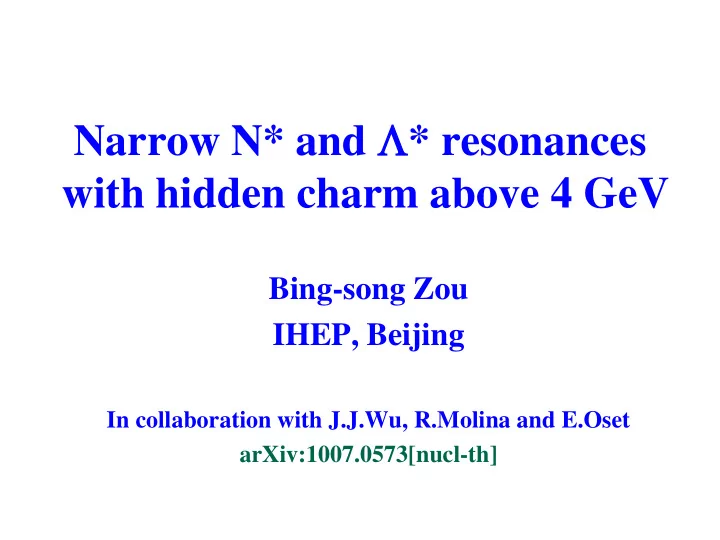

Narrow N* and L * resonances with hidden charm above 4 GeV Bing-song Zou IHEP, Beijing In collaboration with J.J.Wu, R.Molina and E.Oset arXiv:1007.0573[nucl-th]
Outline 1. “Exotic” pp, pK and p N S-wave interactions 2. Possible hadron-hadron bound states 3. From ` K S,`K p bound states to ` D S c , ` D s L c bound states
1. “Exotic” pp, pK and p N S-wave interactions Similarity for pp, pK and p N s-wave scattering pp ( I=0) p N (I=1/2) pK (I=1/2) p + p + p + p p + K +
“Exotic” pp S-wave interaction : broad s- background with narrow resonances as dips instead of peaks I=1 P-wave Exotic I=0 S-wave r (770) I=0 D-wave I=1 F-wave f 2 (1270) r 3 (1690) D.V.Bugg, A.Sarantsev,B.S.Zou, Nucl. Phys. B471 (1996) 59
What’s the nature of the broad s ? Important role by t-channel r exchange for all these processes p p r p p pp pK & pN K r I=2 , K r I =0 = - 2 K r I =1/2 = - 2 K r I=3/2 D. Lohse, J.W. Durso, K. Holinde, J. Speth, Nucl.Phys.A516, 513 (1990) B.S.Zou, D.V.Bugg, Phys. Rev. D50, 591 (1994) An interesting paper by T.Hyodo, D.Jido, A.Hosaka, PRL 97 (2006) 192002 “ Exotic hadrons in s-wave chiral dynamics”
Basic features of I=2 pp Interaction F.Q.Wu, B.S.Zou et al., Nucl. Phys.A735 (2004) 111 attractive force by t-channel f 2 repulsive force by t-channel r S-wave Inelasticity by pp rr
An important cause for hadron-hadron S-wave interactions appearing “exotic” is t-channel meson-exchange amplitude has a comparable strength as s-channel resonance contribution for S-waves. For higher partial waves, s-channel resonance contribution dominates.
2. Possible hadron-hadron bound states f 0 (980) -- ` KK bound state ? Yes, if dropping q-dependent term S.Krewald et al., PRD69 (2004) 016003 No, if keeping q-dependent term Y.J.Zhang et al., PRD74 (2006) 014013 N*(1535) -- ` K S bound state ? Yes, coupled with other meson-baryon channels Weise, Oset , … Not purely meson-baryon state Hyodo-Jido-Hosaka, PRC78 (2008)025203
Possible S-wave bound-states of two pseudoscalar mesons Y.J.Zhang, H.C.Chiang, P.N.Shen and B.S.Zou, PRD74 (2006) 014013
Possible 0 ++ ` DD bound state X(3720) Y.J.Zhang, H.C.Chiang, P.N.Shen, B.S.Zou, PRD74 (2006) 014013 With t-channel r , w exchange and FF : with L = 1.8 ~ 2.0 GeV M X = 3709 ~ 3729 MeV D.Gamermann, E.Oset et al., PRD76 (2007) 074016 Dynamically generated resonance with chiral unitary approach M X ~ 3719 MeV Look for X(3720) from y(3770) g X(3720) D.Gamermann, E.Oset, B.S.Zou, EPJA41 (2009) 85
New Scheme for N*(1535) and its 1/2 - nonet partners B.S.Zou, EPJA35(2008)325 ` q ½ - ` q ½+ u u S d ` q ` q [ud] [ud] [us] } L=0 [ud] } L=1 u d u d Zhang et al, hep-ph/0403210 N*(1535) ~ uud (L=1) + e [ud][us] ` s + … N*(1440) ~ uud (n=1) + x [ud][ud] ` d + … L *(1405) ~ uds (L=1) + e [ud][su] ` u + … N*(1535): [ud][us] ` s larger coupling to N h, N h ’ , N f & K L , weaker to N p & K S, and heavier !
The breathing mode for the N*(1535) u u u u S S ` s ` s d d u d u d u u Important role for N* EM form factor An & Zou, EPJA39(2009)195
Many other proposed dynamically generated states Problem: None of them can be clearly distinguished from qqq or ` qq due to tunable ingredients and possible large mixing of various configurations
3. From ` K S,`K p bound states to ` D S c , ` D s L c bound states J.J.Wu, R.Molina, E.Oset, B.S.Zou. arXiv:1007.0573[nucl-th]
N* L * N* L *
N* L * N* L * Super-heavy narrow N* and L * with hidden charm ! Definitely not qqq states !
Prediction for PANDA ` pp g ` pp h c 0.07 -- 0.7 m b
3 orders of magnitude smaller than N* p h c ` pp g ` ppJ/ y ~ 0.03 nb ~ 250 events per day at PANDA/FAIR by L=10 31 cm -2 s -1 These Super-heavy narrow N* and L * can be found at PANDA !
Prediction for 12GeV@JLab
Conclusion • Super heavy narrow N* and L * are predicted to exist • They are definitely not qqq baryons • They can be looked for at 12GeV@Jlab and PANDA
Recommend
More recommend